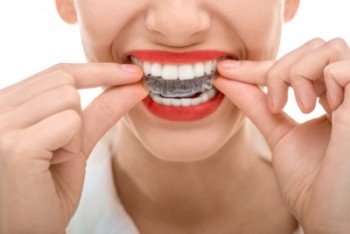Invisalign is a relatively straightforward method of aligning teeth. You wear the clear aligners for a minimum of 20 hours a day. You change the almost-invisible aligners as indicated by your dentist in your customized orthodontic plan, usually every two weeks, give or take. Your teeth move as they’re supposed to and, over time, your teeth and jaw are aligned. But what about caring for your aligners? Because they’re certainly not self-cleaning. Turns out, this task is pretty clear-cut too.
Teens conquer their orthodontic fears with Invisalign >>
Cleaning Metal Braces vs. Invisalign
Traditional braces-wearers may find themselves near tears some days as they struggle to remove a piece of food from their wires or brackets. They have to work meticulously to brush and floss thoroughly enough so that they don’t leave food stuck in their teeth, thereby risking bad breath or abandoning bacteria that develops into cavities.
Invisalign-wearers have the pleasure of being able to eat whatever they want because they simply have to remove their aligners to indulge. And cleaning their own teeth is easy because they floss and brush as usual after removing the aligners. It’s at this time that the wearer of Invisalign is also responsible for tending to the cleaning of the aligners though, and this is one task you don’t want to neglect.
Best Practices for Cleaning Invisalign Trays
The cleanliness of your Invisalign aligners is critical for several reasons. Here are some important points to keep in mind as you go about your daily life wearing Invisalign:
- Don’t be lazy. Even though Invisalign aligners are exchanged for new ones every few weeks, the aligners must be cleaned properly while they’re being used. You can’t “make them last” just because you don’t feel like cleaning the aligners – it only takes a few minutes to protect your Invisalign trays, and your teeth.
- Your aligners can become discolored. Presumably, one of the main reasons you chose Invisalign to straighten your teeth is because it’s hardly noticeable. If you want your aligners to stay clear as well as odor-free and bacteria-free, they have to be kept clean. That means cleaning them exactly as your dentist has indicated.
- Toothpaste is a no-no. Yes, use toothpaste to brush your teeth, but do not use toothpaste on your Invisalign trays. Abrasive whitening toothpastes are especially bad for your aligners and can damage or dull the Invisalign trays. It is OK to brush your aligners, but keep a separate soft toothbrush for this job and brush gently to avoid scratching the trays.
- Get to soaking. Your dentist will recommend an Invisalign tray cleaning solution or the official Invisalign cleaning crystals so you can properly and regularly sanitize and clean the aligners. This is the best method for cleaning your aligners, plus it’s easy and not at all demanding.
- Don’t neglect the little stuff. Rinse your aligners every time you remove them and before you put them back in your mouth. This easy act rinses away saliva and plaque and helps keep bacteria at bay.
- Be conscious of your actions. It can be frustrating, particularly if you are a regular snacker or coffee-drinker, to remove your Invisalign every time you want to eat or drink something. But do yourself and your trays a favor and don’t eat or drink anything but water while wearing Invisalign. Foods and beverages can stain your Invisalign trays.
5 reasons Invisalign is better than metal braces >>
It’s important to care for your teeth and your Invisalign trays with the same level of enthusiasm. Keeping up with good oral hygiene ensures that your form-fitting Invisalign treatment isn’t trapping bacteria between your aligners and your teeth, allowing the two to sit in close contact for hours at a time. And the effort of keeping up with the maintenance of your Invisalign trays is worth it – your orthodontic treatment will be completed in less time than traditional metal braces and you’ll have a beautifully aligned smile to enjoy.
Make your appointment with Dr. Carole Sherrod Jewell, a certified Invisalign provider at Red Bank Dentistry, to find out whether you’re a good candidate for Invisalign.



